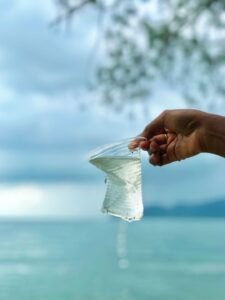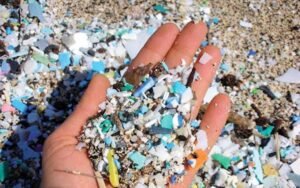A recent study on ‘microplastics’ in the Proceedings of the National Academy of Sciences revealed alarming findings about plastic bottled water. On average, a liter of water in a plastic bottle contains around 240,000 detectable plastic fragments, much more than previous estimates. These tiny particles, known as microplastics and possibly even smaller nanoplastics, are raising health concerns.
The study is titled “Rapid single-particle chemical imaging of nanoplastics by SRS microscopy” and was published on the proceedings of the National Academy of Sciences on January 8, this year.
Microplastics are particles measuring between one micrometer and five millimeters in length. Nanoplastics are even smaller, less than one micrometer. These minuscule particles can enter our bodies when we consume water from plastic bottles, and their effects on health are a growing area of concern.

Study conclusions
Scientists employed an advanced hyperspectral SRS imaging platform to study micro-nano plastics in bottled water. They discovered an unexpectedly high concentration of about 105 particles per liter—two to three orders of magnitude more than previous estimates. These nanoplastics, constituting 90% of all plastic particles, were invisible under regular imaging methods. Identification challenges arose in categorizing the plastic types which has revealed the complexity of chemical composition analysis.
The study revealed variations in particle size distribution based on different chemical compositions which has challenged previous assumptions about plastic toxicity. This interplay between particle structure of plastics and their chemical makeup holds profound implications for toxicity assessments, emphasizing the need for a multidimensional approach. In essence, this groundbreaking research offers valuable insights into the hidden world of ultra-small plastics and their potential impact on health and the environment.
Health Implications of Microplastics Ingestion
Dr. Alokit Gulati, a senior gastroenterologist, highlights that the small size of nanoplastics can trigger inflammatory responses in the body. While the long-term effects remain uncertain there is a need for sustained research to understand them better.

When ingested, these micro and nanoplastics are easily absorbed in the intestine, transported to the liver, and get deposited there. Animal studies have shown that this process takes around 15 minutes. Once in the liver, these particles can cause inflammation and cell death. In the lungs, they damage blood vessels and tissue.
Microplastics and Heart Health: A Growing Concern
Moreover, various studies have linked microplastics to heart health issues. A recent study found microplastic specimens in cardiac tissues from patients undergoing cardiac surgery. These microplastics, up to 469 micrometers in diameter, were associated with inflammation within the heart’s cells and thickening of the heart coverings. These issues can lead to alterations in heart rate and abnormal heart rhythm. Microplastics can also damage blood vessels, potentially leading to blockages, and alter the activity of blood cells, increasing the risk of clotting.

A Malaysian study in 2021 indicated the impact of nanoplastics on oxidative stress, inflammatory reactions, and metabolism disorders. Mouse studies have suggested that micro and nanoplastics could raise the risk of Parkinson’s disease, disrupt fetal development, and impact fertility.
Taking Action Against Plastic Contamination
In terms of preventive measures, Dr. Gulati emphasizes minimizing the use of single-use plastics, ensuring proper waste disposal, choosing tap water over bottled water, using filtration systems, and staying informed. He recommends using steel for food storage instead of plastics. These measures can contribute to reducing our exposure to harmful plastic particles and their potential health effects.










